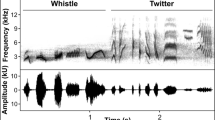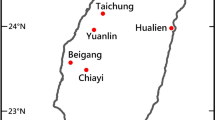Abstract
Vermilion flycatchers, a suboscine, sing songs with more elements in territories with higher urban noise levels. We tested the hypothesis that this pattern is achieved through vocal flexibility, by which individuals add elements to their songs when noise increases; we also tested whether males modulate other song attributes and song output with noise. To this end, we did a playback experiment with free-living males where we recorded their songs during three noise treatments: first ambient noise (FAN), high urban noise (HUN), and second ambient noise (SAN) treatments. We counted the number of song elements and measured acoustic attributes both in the whole song and in the song terminal element (T). Males did not modify the number of song elements, nor song minimum frequency, with noise. The T minimum frequency slightly increased during SAN when compared to the FAN and HUN treatments, but it did not differ between the HUN and FAN treatments. Thus, we interpret these results as a lack of reliable evidence of immediate noise-induced song flexibility in frequency parameters. Song entropy decayed during the trials, but this seemed to be an effect of time and not a noise-induced change. Vermilion flycatchers appear to be less capable of modulating spectral song attributes to cope with noise than many oscines. We discuss other potential strategies that this species may use to deal with noise and a possible mechanism by which males end up singing longer songs in noisier territories (natural selection).




Similar content being viewed by others
References
Bermúdez-Cuamatzin E, Ríos-Chelén AA, Gil D, Macías Garcia C (2011) Experimental evidence for real-time song frequency shift in response to urban noise in a passerine bird. Biol Lett 7:36–38
Brumm H, Slabbekoorn H (2005) Acoustic communication in noise. Adv Stud Behav 35:151–209
Brumm H, Slater PJB (2006) Ambient noise, motor fatigue, and serial redundancy in chaffinch song. Behav Ecol Sociobiol 60:475–481
Brumm H, Zollinger SA (2011) The evolution of the Lombard effect: 100 years of psychoacoustic research. Behaviour 148:1173–1198
Brumm H, Zollinger SA (2013) Avian vocal production in noise. In: Brumm H (ed) Animal communication and noise. Animal signals and communication, vol 2. Springer, Berlin, pp 187–227
Brumm H, Zollinger SA, Niemelä PT, Sprau P (2017) Measurement artefacts lead to false positives in the study of birdsong in noise. Methods Ecol Evol. doi:10.1111/2041-210X.12766
Cartwright LA, Taylor DR, Wilson DR, Chow-Fraser P (2014) Urban noise affects song structure and daily patterns of song production in red-winged blackbirds (Agelaius phoeniceus). Urban Ecosyst 17:561–572
Davidson BM, Antonova G, Dlott H, Barber JR, Francis CD (2017) Natural and anthropogenic sounds reduce song performance: insights from two emberizid species. Behav Ecol, On-line version. doi:10.1093/beheco/arx036
Diaz M, Parra A, Gallardo C (2011) Serins respond to anthropogenic noise by increasing vocal activity. Behav Ecol 22:332–336
Francis CD, Barber JR (2013) A framework for understanding noise impacts on wildlife: an urgent conservation priority. Front Ecol Environ 11:305–311
Francis CD, Ortega CP, Cruz A (2011a) Different behavioural responses to anthropogenic noise by two closely related passerine birds. Biol Lett 7:850–852
Francis CD, Ortega CP, Cruz A (2011b) Vocal frequency change reflects different responses to anthropogenic noise in two suboscine tyrant flycatchers. Proc R Soc B 278:2025–2031
Fuller RA, Warren PH, Gaston KJ (2007) Daytime noise predicts nocturnal singing in urban robins. Biol Lett 3:368–370
Gentry KE, McKenna MF, Luther DA (2017) Evidence of suboscine song plasticity in response to traffic noise fluctuations and temporary road closures. Bioacoustics. doi:10.1080/09524622.2017.1303645
Gil D, Brumm H (2014) Acoustic communication in the urban environment: patterns, mechanisms, and potential consequences of avian song adjustments. In: Gil D, Brumm H (eds) Avian urban ecology. Oxford University Press, Oxford, pp 69–83
Grace MK, Anderson RC (2015) No frequency shift in the “D” notes of Carolina chickadee calls in response to traffic noise. Behav Ecol Sociobiol 69:253–263
Gross K, Pasinelli G, Kunc HP (2010) Behavioral plasticity allows short term adjustment to a novel environment. Am Nat 176:456–464
Halfwerk W, Slabbekoorn H (2009) A behavioural mechanism explaining noise dependent frequency use in urban birdsong. Anim Behav 78:1301–1307
Hanna D, Blouin-Demers G, Wilson DR, Mennill DJ (2011) Anthropogenic noise affects song structure in red-winged blackbirds (Agelaius phoeniceus). J Exp Biol 214:3549–3556
Hansen P (1979) Vocal learning: its role in adapting sound structures to long-distance propagation, and a hypothesis on its evolution. Anim Behav 27:270–1271
Kight CR, Swaddle JP (2011) How and why environmental noise impacts animals: an integrative, mechanistic review. Ecol Lett 14:1052–1061
Kight CR, Swaddle JP (2015) Eastern bluebirds alter their song in response to anthropogenic changes in the acoustic environment. Intgr Comp Biol 55:418–431
Kroodsma DE (1984) Songs of the alder flycatcher (Empidonax alnorium) and the willow flycatcher (Empidonax traillii) are innate. Auk 101:3–23
Kroodsma DE (2004) The diversity and plasticity of birdsong. In: Nature’s Music. The science of birdsong. (Marler P, Slabbekoorn H eds). Elsevier, pp. 108–131
Kroodsma DE, Konishi M (1991) A suboscine bird (eastern phoebe, Sayornis phoebe) develops normal song without auditory feedback. Anim Behav 42:477–487
Lohr B, Wright TF, Dooling RJ (2003) Detection and discrimination of natural calls in masking noise by birds: estimating the active space of a signal. Anim Behav 65:763–777
McLaughlin KE, Kunc HP (2013) Experimentally increased noise levels change spatial and singing behaviour. Biol Lett 9:20120771
Montague MJ, Danek-Gontard M, Kunc HP (2012) Phenotypic plasticity affects the response of a sexually selected trait to anthropogenic noise. Behav Ecol 24:343–348
Patricelli GL, Blickley JL (2006) Avian communication in urban noise: causes and consequences of vocal adjustment. Auk 123:639–649
Podos J (1997) A performance constraint on the evolution of trilled vocalizations in a songbird family (Passeriformes: Emberizidae). Evolution 51:537–551
Podos J (2001) Correlated evolution of morphology and vocal signal structure in Darwin’s finches. Nature 409:185–188
Podos J, Nowicki S (2004) Performance limits on birdsong. In: Nature’s music, the science of birdsong (Marler P, Slabbekoorn H, eds.). Elsevier, pp. 318–342
Potvin DA, Mulder RA (2013) Immediate, independent adjustment of call pitch and amplitude in response to varying background noise by silvereyes (Zosterops lateralis). Behav Ecol 24:1363–1368
Ríos-Chelén AA (2009) Bird song: the interplay between urban noise and sexual selection. Oecol Bras 13:153–164
Ríos-Chelén AA, Lee GC, Patricelli GL (2015) Anthropogenic noise is associated with changes in acoustic but not visual signals in red-winged blackbirds. Behav Ecol Sociobiol 69:1139–1159
Ríos-Chelén AA, Lee GC, Patricelli GL (2016) A comparison between two ways to measure minimum frequency and an experimental test of vocal plasticity in red-winged blackbirds in response to noise. Behaviour 153:1445–1472
Ríos Chelén AA, Macías Garcia C, Riebel K (2005) Variation in the song of a sub-oscine, the vermilion flycatcher. Behaviour 142:1121–1138
Ríos-Chelén AA, McDonald AN, Berger A, Perry AC, Krakauer AH, Patricelli GL (2017) Do birds vocalize at higher pitch in noise, or is it a matter of measurement? Behav Ecol Sociobiol 71:29
Ríos-Chelén AA, Quirós-Guerrero E, Gil D, Macías Garcia C (2013) Dealing with urban noise: vermilion flycatchers sing longer songs in noisier territories. Behav Ecol Sociobiol 67:145–152
Ríos-Chelén AA, Salaberria C, Barbosa I, Macías Garcia C, Gil D (2012) The learning advantage: bird species that learn their song show a tighter adjustment of song to noisy environments than those that do not learn. J Evol Biol 25:2171–2180
Rivera-Cáceres K, Macías Garcia C, Quirós-Guerrero E, Ríos-Chelén AA (2011) An interactive playback experiment shows song bout size discrimination in the suboscine vermilion flycatcher (Pyrocephalus rubinus). Ethology 117:1120–1127
Slabbekoorn H (2013) Songs of the city: noise-dependent spectral plasticity in the acoustic phenotype of urban birds. Anim Behav 85:1089–1099
Slabbekoorn H, Smith TB (2002) Habitat-dependent song divergence in the little greenbul: an analysis of environmental selection pressures on acoustic signal. Evolution 56:1849–1858
Schuster S, Zollinger SA, Lesku JA, Brumm H (2012) On the evolution of noise-dependent vocal plasticity in birds. Biol Lett 8:913–916
Suthers RA (2004) How birds sing and why it matters. In: Nature’s music, the science of birdsong (Marler P, Slabbekoorn H, eds.). Elsevier, pp. 272–295
Smith WJ (1967) Displays of the vermilion flycatcher (Pyrocephalus rubinus). Condor 69:601–605
Swets JA, Birdsall TG (1978) Repeated observation of an uncertain signal. Percept Psychophys 23:269–274
Swets JA, Shipley EF, JMcKee JM, Green DM (1959) Multiple observations of signals in noise. J Acoust Soc Am 31:514–521
Vallet E, Kreutzer M (1995) Female canaries are sexually responsive to special song phrases. Anim Behav 49:1603–1610
Verzijden MN, Ripmeester EA, Ohms VR, Snelderwaard P, Slabbekoorn H (2010) Immediate spectral flexibility in singing chiffchaffs during experimental exposure to highway noise. J Exp Biol 213:2575–2581
Wiley RH (2006) Signal detection and animal communication. Adv Stu Behav 36:217–247
Wilson DR, Bitton P-P, Podos J, Mennill DJ (2014) Uneven sampling and the analysis of vocal performance constraints. Am Nat 183:214–228
Zollinger SA, Podos J, Nemeth E, Goller F, Brumm H (2012) On the relationship between, and measurement of, amplitude and frequency in bird song. Anim Behav 84:e1–e9
Acknowledgements
This work was supported by a postdoctoral fellowship from Consejo Nacional de Ciencia y Tecnología (CONACYT) awarded to A.A.R.CH. We are grateful to three reviewers that help improve the quality of this article.
Author information
Authors and Affiliations
Corresponding author
Ethics declarations
Conflict of interest
Authors declare no conflict of interest.
Rights and permissions
About this article
Cite this article
Ríos-Chelén, A.A., Cuatianquiz-Lima, C., Bautista, A. et al. No reliable evidence for immediate noise-induced song flexibility in a suboscine. Urban Ecosyst 21, 15–25 (2018). https://doi.org/10.1007/s11252-017-0690-1
Published:
Issue Date:
DOI: https://doi.org/10.1007/s11252-017-0690-1




